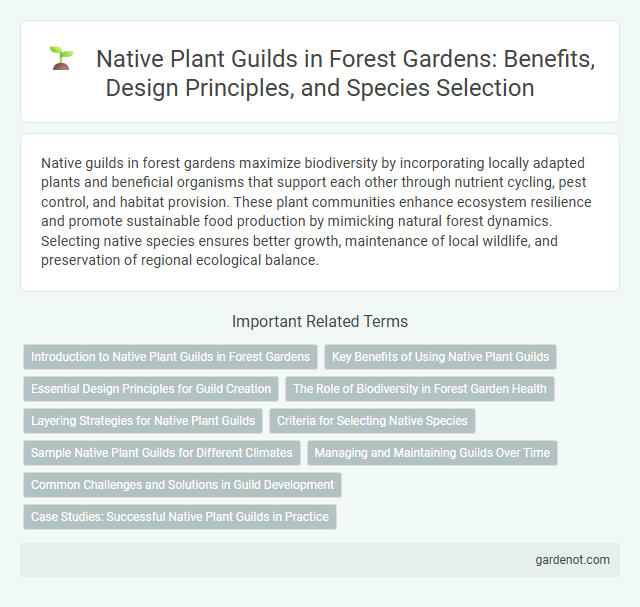Native guilds in forest gardens maximize biodiversity by incorporating locally adapted plants and beneficial organisms that support each other through nutrient cycling, pest control, and habitat provision. These plant communities enhance ecosystem resilience and promote sustainable food production by mimicking natural forest dynamics. Selecting native species ensures better growth, maintenance of local wildlife, and preservation of regional ecological balance.
Introduction to Native Plant Guilds in Forest Gardens
Native plant guilds in forest gardens create symbiotic plant communities that support and enhance ecosystem health by mimicking natural forest layers. These guilds typically include nitrogen-fixing plants, dynamic accumulators, ground covers, and pollinator attractors, each fulfilling specific ecological roles. Incorporating native species within these guilds promotes biodiversity, resilience, and sustainable nutrient cycling in forest garden ecosystems.
Key Benefits of Using Native Plant Guilds
Native plant guilds in forest gardens enhance biodiversity by creating symbiotic relationships among plants adapted to local ecosystems. These guilds improve soil health through natural nutrient cycling and reduce water usage by leveraging plants with complementary water needs. The incorporation of native species also supports local wildlife, promoting pollination and pest control while maintaining ecological balance.
Essential Design Principles for Guild Creation
A native guild in a forest garden integrates complementary plant species that support nutrient cycling, pest control, and pollination to create a resilient ecosystem. Essential design principles include selecting nitrogen-fixing plants, dynamic accumulators, and ground covers that optimize resource use and soil health. Incorporating vertical layers and temporal diversity ensures maximum spatial efficiency and continuous yields throughout the growing season.
The Role of Biodiversity in Forest Garden Health
Native guilds in forest gardens enhance ecosystem resilience by fostering biodiversity through complementary plant relationships. Diverse species support nutrient cycling, pest control, and soil fertility, creating a self-sustaining environment. This layered biodiversity reduces dependency on external inputs and boosts overall forest garden health and productivity.
Layering Strategies for Native Plant Guilds
Layering strategies in native plant guilds enhance biodiversity and resilience by combining canopy, understory, shrub, herbaceous, and ground cover plants that naturally coexist in forest gardens. These layers optimize resource use, improve soil health, and create microhabitats for pollinators and beneficial insects. Implementing diverse native species like oak trees, hazelnut shrubs, wild ginger, and ferns promotes ecological balance and long-term sustainability.
Criteria for Selecting Native Species
Native guilds in forest gardens thrive when species are selected based on adaptability to local climate, soil type, and biodiversity compatibility. Prioritizing plants that support native pollinators, enhance soil fertility, and provide habitat ensures ecosystem resilience and sustainability. Selecting species with complementary growth habits and resource use optimizes space and promotes mutual benefits within the guild.
Sample Native Plant Guilds for Different Climates
Sample native plant guilds vary significantly across climates, incorporating species adapted to local soil, rainfall, and temperature patterns. In temperate zones, a typical guild might include nitrogen-fixing clover, deep-rooted comfrey, and berry-producing elderberry to improve soil health and provide food sources. Arid climate guilds often feature drought-tolerant sages, mesquite trees for shade and nitrogen fixation, and native groundcovers like desert marigold to enhance biodiversity and conserve moisture.
Managing and Maintaining Guilds Over Time
Managing and maintaining native plant guilds in forest gardens requires regular monitoring of species health, soil conditions, and pest populations to ensure ecological balance and productivity. Implementing adaptive pruning, mulching, and selective harvesting techniques supports sustained growth and resilience within the guild. Long-term stewardship includes replanting native species and integrating seasonal adjustments to maintain biodiversity and ecosystem functionality.
Common Challenges and Solutions in Guild Development
Native guild development in forest gardens often faces challenges such as species compatibility, soil nutrient competition, and pest management. Implementing diverse plant selections with complementary root depths and nutrient needs helps mitigate competition, while incorporating native pest-resistant species supports ecosystem balance. Regular monitoring and adaptive management strategies enhance overall guild resilience and productivity.
Case Studies: Successful Native Plant Guilds in Practice
Successful native plant guilds demonstrate enhanced biodiversity, soil health, and pest resistance by mimicking natural ecosystems through strategic plant layering and species selection. Case studies from the Pacific Northwest reveal native guilds incorporating serviceberries, Oregon grape, and salal, which support pollinators and wildlife while improving nutrient cycling. These examples highlight that integrating culturally significant plants with native companions fosters resilient, self-sustaining forest gardens with long-term ecological benefits.
Native guild Infographic

 gardenot.com
gardenot.com